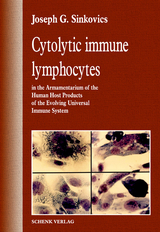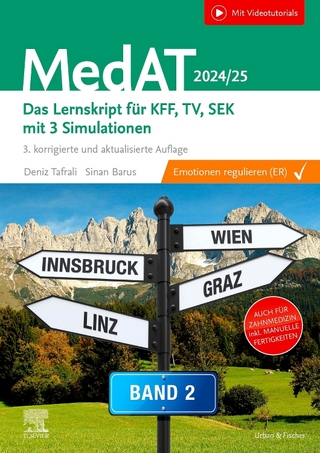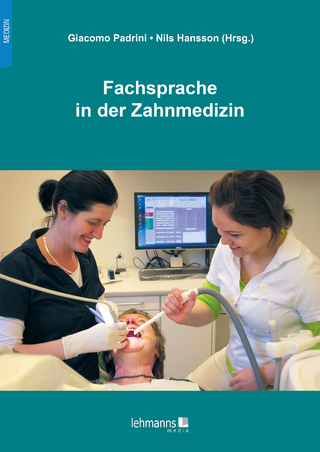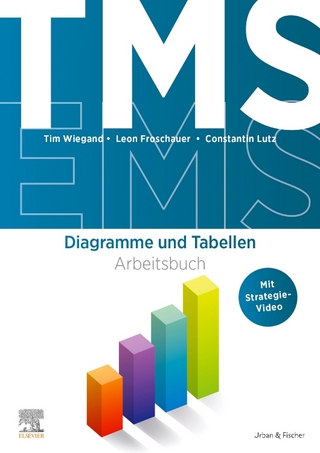Cytolytic immune lymphocytes
In the Armamentarium of the Human Host Products of the Evolving Universal Immune System
Seiten
2008
|
1., Aufl.
Schenk Verlag
978-3-939337-57-7 (ISBN)
Schenk Verlag
978-3-939337-57-7 (ISBN)
The Monograph: “Cytotoxic Lymphocytes of the Human Host. Products of the Evolving Universal Immune System.” Joseph G. Sinkovics. St. Joseph’s Hospital Cancer Institute Affiliated with the H.L. Moffitt Comprehensive Cancer Center at the University of South Florida; Departments of Medical Microbiology & Immunology, and Molecular Medicine, University of South Florida College of Medicine, Tampa, FL, USA.
The German-Hungarian Publisher SchenkVerlag Campus Dialog (Pécs, Hungary; Passau, Germany: dialogv@t-online.de) publishes this monograph. This presentation is an illustrated account of the monograph’s contents. Part I is devoted to molecular cell biology re-capitulating the formation of the first cells, their vertical and horizontal acquisition of new genes, using for examples extant archaea and primitive prokaryotes. A bold proposal is elaborated on the formation of the first eukaryotic nucleated cells from ancient virally mediated fusions of archaeal and prokaryotic spheroplasts. A detailed account on the evolution of viruses follows. The well preserved innate immune faculties (TLRs, chemokines, cytokines, complement, opsonins and bactericidal substances) include a detailed description of the interferons, and interfering iRNAs. The first multicellular organisms in the Cambrian sea already possessed dendritic cells and natural killer (NK) cells. Part II traces back the origin of the RAG, RSS and V(D)J genomic sequences to ancient retrotransposons entering the genomes of ancient sharks. Another original proposal is that an ancestral herpesvirus transduced the RAG genes from sea urchins to sharks; the extant EBV still operates RAG-like genomic sequences. The entire adaptive immune system consisting of NKT, CD4 and CD8 T cells and antibody-secreting plasma cells becomes functional at this level. On one side, there is a fine-tuned cooperation between the innate and adaptive immune systems. On the other side, the mammalian placenta compromised the united innate and adaptive immune system by forcing it to accept the semi-allogeneic fetus. In terms of molecular immunobiology, both the placenta (temporarily), and the malignant tumor (permanently) utilize the same mechanisms of immunosuppression in order to achieve acceptance and nurturing by the host. Part III is devoted to human tumor immunology/immunotherapy (vaccines; adoptive immune lymphocyte therapy and monoclonal antibodies). In an extraordinary chapter, the author describes the formation of a natural hybridoma between an antibody-secreting plasma cell and a lymphoma cell in the mouse; the description of this well documented and understood natural hybridoma predated by 5 years the Nobel-Prize winning discovery of Köhler & Milstein. Now the author proposes that the Sézary cell is a natural T cell hybridoma formed by the malignant mycosis fungoides T cell and a regulatory T cell. Part IV is devoted to molecular immunobiology of human autoimmune diseases. The reactivation of HER occurring during somatic hypermutations of lymphoid cells receives great attention, as budding HER particles appear in lymphoid cell involved both in lymphomagenesis and autoimmunity. Part V compares the generation of Th1- and Th2-type immune reactions of the host to exogenous pathogens (viruses, bacteria, fungi, parasites and worms) and to endogenous tumor cells. The comparison yields fascinating results. Part VI is a Concise Synopsis summarizing the most recent data from 2007-8 of molecular cell biology and immunology, epigenetic tumor cell biology, the newest results with tumor vaccines, oncolytic viruses, and adoptive therapy with immune lymphocytes. There are 16 summary Tables and 12 large illustrations (figures, plates and graphs); and the number of selected and explained up-to-date references reaches 2370.
TLR = Toll-like receptors RAG = recombination activating genes RSS = recombination signal sequences
V(D)J = variable, diversity, joining EBV = Epstein-Barr virus HER =human endogenous retroviruses.
"PREFACE & INTRODUCTION
The author of this volume submits this material to the reader with great personal satisfaction. All of the meanings of the word “satisfaction,” as listed in the dictionaries, apply: 1. amends and reparations (this is the opportunity to correct past mistakes); 2. the payment through penance of the temporal punishment incurred by a sin (no sin was committed, but the penance is deserved for the mistakes the author inadvertently perpetrated); 3. fulfillment of enjoyment (deprived of its own laboratory, in reading the reports published from other laboratories, the author felt as if the whole world of medical research were working for his pleasure); 4. compensation for a loss, or injury (losses and injuries occurred unjustifiably and plenteously to this author). However, he feels the rising of a warm contact between him and the readers, as the readers’ sincere interest in his works compensates him now for all his losses and injuries of the past. The author reports with great elation that he has enjoyed his work, weather it was compensated or not. He was not subdued and eliminated; he preserved his faculties, so that he is able to submit this report to the readers. His intentions are to render a service to those, who work in the laboratories, in the clinics and in the hospitals, and simply do not have the time to absorb up the outpour of countless reports on new developments in research on virology and immunology. He wishes to entertain those, who appreciate the fascination that new discoveries engender in our minds. The young investigators, who are working towards their PhD and/or MD degrees, in reading this book, may recognize the directions that will be most attractive to them for their further advancement. To them the author advises restrains with their own new discoveries: if you are just two or three years ahead of the front line, you may be recognized and shall eventually be rewarded. If you are five to ten years ahead of the front line, you will be ridiculed, dismissed and even your grant support may be canceled. Do your best to survive until somebody re-discovers your original discovery, and hope that then you will still be remembered.
The first draft of this manuscript was prepared at the very end of 2006 and early in 2007. Then there was a waiting period in search of a publisher. The publisher of this manuscript was expected to accept some deviations from the “norms”. These are some personal comments of the author defying the customary rigid scientific style of monographs and textbooks; the preference of the author to cite from the rich, but often unrecognized Hungarian scientific literature; and the author’s elaborate explanatory legends under the illustrations, some of which are of true historical value. From the publisher’s part, willingness to republish illustrations and data from the pre-digital, pre-electronic era; and unusual expertise to accommodate the author’s elaborate tables written in a telegraphic style, was required. It was the editor-in-chief of the Dialog Campus Publisher at Pécs and Budapest, Hungary, and Schenk Verlag, Passau, Germany, Mr. János Schenk, who had the courage, the vision, and the knowledge as to how to print and publish this book. One of the publisher’s last volumes, the monumental Népegészségügyi Orvostan, edited by Professor István Ember, stood for itself as a testimony and proof for the publisher’s expertise in releasing art and science combined in a superb format. At this point in late 2007 and early 2008, the Concise Synopsis with up-dated references was added to the manuscript. The author is grateful to Mr. Schenk and his staff, co-workers for their extraordinary attention to, and talent in, successfully resolving the problems, with which the format and the outward aspects and appearance of this book challenged them.
In the text the reader finds the literature citations in squared parentheses. In rounded parentheses in bold numbers are the cross references: if a subject matter is discussed at several separate sites, those could easily be located by looking them up, as the given chapter numbers so indicate. References to Figures and Tables are also in bold in rounded parentheses.
The author wishes to dedicate this book with profound gratitude to the memory of his mother, Mária. She was the one who enrolled him, her young son József, in the medical school in Budapest in 1942-3, and stood in line with the young students to validate all the required classes in the curriculum. Her hand-writing to this effect is shown in the author’s first year enrollment student book, the Index (see in the Figure), and she paid the tuition for the first year. This act of the caring and loving mother gave her rebellious son a life-time devotion: a full time engagement in medical research and in the practice of medicine.
Sincerely,
Joseph G. Sinkovics
"
The German-Hungarian Publisher SchenkVerlag Campus Dialog (Pécs, Hungary; Passau, Germany: dialogv@t-online.de) publishes this monograph. This presentation is an illustrated account of the monograph’s contents. Part I is devoted to molecular cell biology re-capitulating the formation of the first cells, their vertical and horizontal acquisition of new genes, using for examples extant archaea and primitive prokaryotes. A bold proposal is elaborated on the formation of the first eukaryotic nucleated cells from ancient virally mediated fusions of archaeal and prokaryotic spheroplasts. A detailed account on the evolution of viruses follows. The well preserved innate immune faculties (TLRs, chemokines, cytokines, complement, opsonins and bactericidal substances) include a detailed description of the interferons, and interfering iRNAs. The first multicellular organisms in the Cambrian sea already possessed dendritic cells and natural killer (NK) cells. Part II traces back the origin of the RAG, RSS and V(D)J genomic sequences to ancient retrotransposons entering the genomes of ancient sharks. Another original proposal is that an ancestral herpesvirus transduced the RAG genes from sea urchins to sharks; the extant EBV still operates RAG-like genomic sequences. The entire adaptive immune system consisting of NKT, CD4 and CD8 T cells and antibody-secreting plasma cells becomes functional at this level. On one side, there is a fine-tuned cooperation between the innate and adaptive immune systems. On the other side, the mammalian placenta compromised the united innate and adaptive immune system by forcing it to accept the semi-allogeneic fetus. In terms of molecular immunobiology, both the placenta (temporarily), and the malignant tumor (permanently) utilize the same mechanisms of immunosuppression in order to achieve acceptance and nurturing by the host. Part III is devoted to human tumor immunology/immunotherapy (vaccines; adoptive immune lymphocyte therapy and monoclonal antibodies). In an extraordinary chapter, the author describes the formation of a natural hybridoma between an antibody-secreting plasma cell and a lymphoma cell in the mouse; the description of this well documented and understood natural hybridoma predated by 5 years the Nobel-Prize winning discovery of Köhler & Milstein. Now the author proposes that the Sézary cell is a natural T cell hybridoma formed by the malignant mycosis fungoides T cell and a regulatory T cell. Part IV is devoted to molecular immunobiology of human autoimmune diseases. The reactivation of HER occurring during somatic hypermutations of lymphoid cells receives great attention, as budding HER particles appear in lymphoid cell involved both in lymphomagenesis and autoimmunity. Part V compares the generation of Th1- and Th2-type immune reactions of the host to exogenous pathogens (viruses, bacteria, fungi, parasites and worms) and to endogenous tumor cells. The comparison yields fascinating results. Part VI is a Concise Synopsis summarizing the most recent data from 2007-8 of molecular cell biology and immunology, epigenetic tumor cell biology, the newest results with tumor vaccines, oncolytic viruses, and adoptive therapy with immune lymphocytes. There are 16 summary Tables and 12 large illustrations (figures, plates and graphs); and the number of selected and explained up-to-date references reaches 2370.
TLR = Toll-like receptors RAG = recombination activating genes RSS = recombination signal sequences
V(D)J = variable, diversity, joining EBV = Epstein-Barr virus HER =human endogenous retroviruses.
"PREFACE & INTRODUCTION
The author of this volume submits this material to the reader with great personal satisfaction. All of the meanings of the word “satisfaction,” as listed in the dictionaries, apply: 1. amends and reparations (this is the opportunity to correct past mistakes); 2. the payment through penance of the temporal punishment incurred by a sin (no sin was committed, but the penance is deserved for the mistakes the author inadvertently perpetrated); 3. fulfillment of enjoyment (deprived of its own laboratory, in reading the reports published from other laboratories, the author felt as if the whole world of medical research were working for his pleasure); 4. compensation for a loss, or injury (losses and injuries occurred unjustifiably and plenteously to this author). However, he feels the rising of a warm contact between him and the readers, as the readers’ sincere interest in his works compensates him now for all his losses and injuries of the past. The author reports with great elation that he has enjoyed his work, weather it was compensated or not. He was not subdued and eliminated; he preserved his faculties, so that he is able to submit this report to the readers. His intentions are to render a service to those, who work in the laboratories, in the clinics and in the hospitals, and simply do not have the time to absorb up the outpour of countless reports on new developments in research on virology and immunology. He wishes to entertain those, who appreciate the fascination that new discoveries engender in our minds. The young investigators, who are working towards their PhD and/or MD degrees, in reading this book, may recognize the directions that will be most attractive to them for their further advancement. To them the author advises restrains with their own new discoveries: if you are just two or three years ahead of the front line, you may be recognized and shall eventually be rewarded. If you are five to ten years ahead of the front line, you will be ridiculed, dismissed and even your grant support may be canceled. Do your best to survive until somebody re-discovers your original discovery, and hope that then you will still be remembered.
The first draft of this manuscript was prepared at the very end of 2006 and early in 2007. Then there was a waiting period in search of a publisher. The publisher of this manuscript was expected to accept some deviations from the “norms”. These are some personal comments of the author defying the customary rigid scientific style of monographs and textbooks; the preference of the author to cite from the rich, but often unrecognized Hungarian scientific literature; and the author’s elaborate explanatory legends under the illustrations, some of which are of true historical value. From the publisher’s part, willingness to republish illustrations and data from the pre-digital, pre-electronic era; and unusual expertise to accommodate the author’s elaborate tables written in a telegraphic style, was required. It was the editor-in-chief of the Dialog Campus Publisher at Pécs and Budapest, Hungary, and Schenk Verlag, Passau, Germany, Mr. János Schenk, who had the courage, the vision, and the knowledge as to how to print and publish this book. One of the publisher’s last volumes, the monumental Népegészségügyi Orvostan, edited by Professor István Ember, stood for itself as a testimony and proof for the publisher’s expertise in releasing art and science combined in a superb format. At this point in late 2007 and early 2008, the Concise Synopsis with up-dated references was added to the manuscript. The author is grateful to Mr. Schenk and his staff, co-workers for their extraordinary attention to, and talent in, successfully resolving the problems, with which the format and the outward aspects and appearance of this book challenged them.
In the text the reader finds the literature citations in squared parentheses. In rounded parentheses in bold numbers are the cross references: if a subject matter is discussed at several separate sites, those could easily be located by looking them up, as the given chapter numbers so indicate. References to Figures and Tables are also in bold in rounded parentheses.
The author wishes to dedicate this book with profound gratitude to the memory of his mother, Mária. She was the one who enrolled him, her young son József, in the medical school in Budapest in 1942-3, and stood in line with the young students to validate all the required classes in the curriculum. Her hand-writing to this effect is shown in the author’s first year enrollment student book, the Index (see in the Figure), and she paid the tuition for the first year. This act of the caring and loving mother gave her rebellious son a life-time devotion: a full time engagement in medical research and in the practice of medicine.
Sincerely,
Joseph G. Sinkovics
"
The author’s experience at bench work in the laboratory (at The University of Texas M D. Anderson Hospital, Houston, and elsewhere), his clinical knowledge and board certifications in laboratory in medical oncology of solid tumors and leukemias-lymphomas, his previously published works in virology, cancer immunology, clinical medical oncology and viral therapy of cancers eminently qualifies him for the expert overview of this complex, but therapeutically promising subject matter.
| Erscheint lt. Verlag | 7.10.2008 |
|---|---|
| Sprache | englisch |
| Maße | 165 x 240 mm |
| Gewicht | 1480 g |
| Einbandart | gebunden |
| Themenwelt | Medizin / Pharmazie ► Studium |
| Schlagworte | HC/Medizin/Nichtklinische Fächer • Immunologie • Krebsforschung • Lymphozyten • Onkologie |
| ISBN-10 | 3-939337-57-9 / 3939337579 |
| ISBN-13 | 978-3-939337-57-7 / 9783939337577 |
| Zustand | Neuware |
| Haben Sie eine Frage zum Produkt? |
Mehr entdecken
aus dem Bereich
aus dem Bereich
Das Lernskript für kognitive Fähigkeiten und Fertigkeiten, …
Buch | Softcover (2023)
Urban & Fischer in Elsevier (Verlag)
45,00 €




